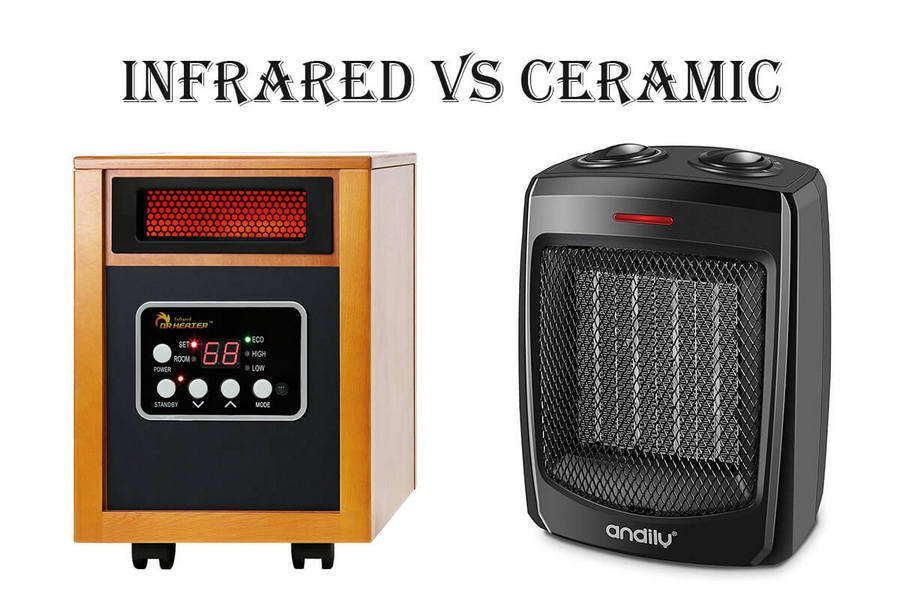Instead of using expensive propane or gas heaters, infrared and ceramic heaters offer an affordable alternative to keep your home warm during the winter season. Both these heaters work on the common principle of physics by converting electrical energy into heat.
However, there are key differences between infrared and ceramic heaters in the basic operations, covered area, cost, noise, and other safety features.
Lucky for you, this guide presents an unbiased comparison of infrared vs ceramic heater. This way, you can make a well-informed decision about buying a suitable portable heater for your home.
Infrared vs Ceramic: Different Heating Methods
While discussing infrared vs ceramic heater, it’s important to understand the underlying heating method of the two space heaters.
A ceramic heater comprises two main components – a heating element and a fan that disperses the warm air in the surrounding. The heating element, which is essentially a positive temperature coefficient (PTC), is a ceramic type that produces heat when the electric current passes through it. Once the element is heated, the fan disperses the hot air in the surrounding area.
Thanks to the circulating fan, the heater doesn’t offer direct heat; instead, it gradually increases the surrounding area’s temperature. Therefore, you can enjoy a warm and cozy environment using a portable ceramic heater.
Conversely, an infrared heater uses infrared radiation to offer direct heat. It means the heater increases the temperature of all the objects in its path.
The infrared radiation concept is quite similar to the rays coming from the sun. The sunlight coming from the sun gets absorbed by the skin and clothes that eventually make us feel warm.
Similarly, our skin absorbs the infrared radiations coming from the space heater. Hence, we need to sit closer to the infrared heater to feel warm.
Unlike ceramic heaters, infrared heaters don’t include a fan to disperse hot air. Instead, the heater offers targeted heating by emitting infrared radiation in the form of waves. On the downside, the heating radius of the infrared heaters is relatively smaller compared to ceramic heaters.
Infrared vs Ceramic Heater: Detailed Comparison
Read along to learn about one on one feature comparison of infrared vs ceramic heater.
Heating Area
Due to the presence of the fan, the heating area of the ceramic heater is undoubtedly larger than the infrared heater.
As discussed above, an infrared heater offers direction or targetted warmth while the fan of the ceramic heater disperses the hot air in the surrounding. The heating impact of infrared heaters is undoubtedly substantial; however, the heating radius is smaller.
As a result, you can only feel the warmth of the infrared rays from the heater that has direct contact with you.
Efficiency
Both ceramic and infrared heaters are energy efficient. The infrared heaters use 100% of the heat produced with almost zero losses while transferring the heat in a particular direction.
Not only that, but an infrared heater requires only 40% of the energy to offer direct warmth to a person.
One of the most significant advantages of the ceramic heater is that the plates cool down faster, offering less heat waste. That’s why ceramic heaters ensure an efficiency of 85-90%, which is great.
Moreover, you can improve the energy efficiency of ceramic heaters by closing the doors and windows of the room to minimize heat dissipation.
An infrared heater takes less time to warm the person sitting next to it. However, you need to operate a ceramic heater for a longer time to warm your living or study room.
The hot air produced by the ceramic heaters stays longer in the surrounding space, making a ceramic heater a perfect candidate to keep the rooms warmer for a relatively long time.
Energy Costs
In terms of cost efficiency, the quartz infrared heaters supersede the ceramic heaters in heating small spaces. Moreover, infrared heaters consume less electricity by offering instant targeted heating.
For instance, an infrared heater consumes around 25 watts per cubic meter. On the contrary, an energy-efficient ceramic heater consumes more than 40 watts of electricity per cubic meter.
Furthermore, the infrared heaters are also inexpensive compared to the standard convection or radiant heaters.
On the other side, buying a ceramic heater is just like making a one-time investment that will help you gradually reduce your electricity bill.
Noise
It’s certainly one of the most significant deciding factors since no one wants to compromise peace and comfort with a noisy heater. That’s why infrared heaters are perfect when it comes to buying noiseless heaters.
On the contrary, the built-in fan of the ceramic heaters certainly creates some constant humming noise at a bearable level.
Safety
Ceramic heaters are safer compared to infrared heaters. It’s because the heat coming from the infrared heaters is quite hot and not at all recommended for toddlers, kids, and pets.
Many ceramic heaters come with an additional safety option to turn off the heater automatically in case of overheating to avoid accidental fire or damage.
Portability
Both ceramic and infrared heaters are lightweight and portable. In addition, you can carry the heaters from one room to another as both of them require an electrical connection.
Ceramic heaters offer a compact and sleek design which is certainly a great benefit. Additionally, many heaters come with an additional safe-to-touch handle that ensures convenient transportation.
You can find different designs in infrared heaters; however, the design of the infrared heater requires you to mount them or ceiling or walls to ensure targeting heating.
Clean Heating
Both infrared and ceramic heaters offer clean heating without emitting any smoke, odor, or fumes in the surrounding. It’s because both of them have electricity as the main source instead of any other fuel.
Read Also: Indoor Heaters That Don’t Require Electricity
Final Thoughts
Portable heaters are gaining popularity because of their convenience, better performance, reduced cost, and maintenance. You require different types of heaters to warm a small cubicle or large, open space.
To sum up the infrared vs ceramic heater comparison, infrared heaters are best to warm a standard room, such as a kitchen, living room, or any room with a standard ceiling highest. Alternatively, a ceramic heater works best in rooms with a high ceiling.







